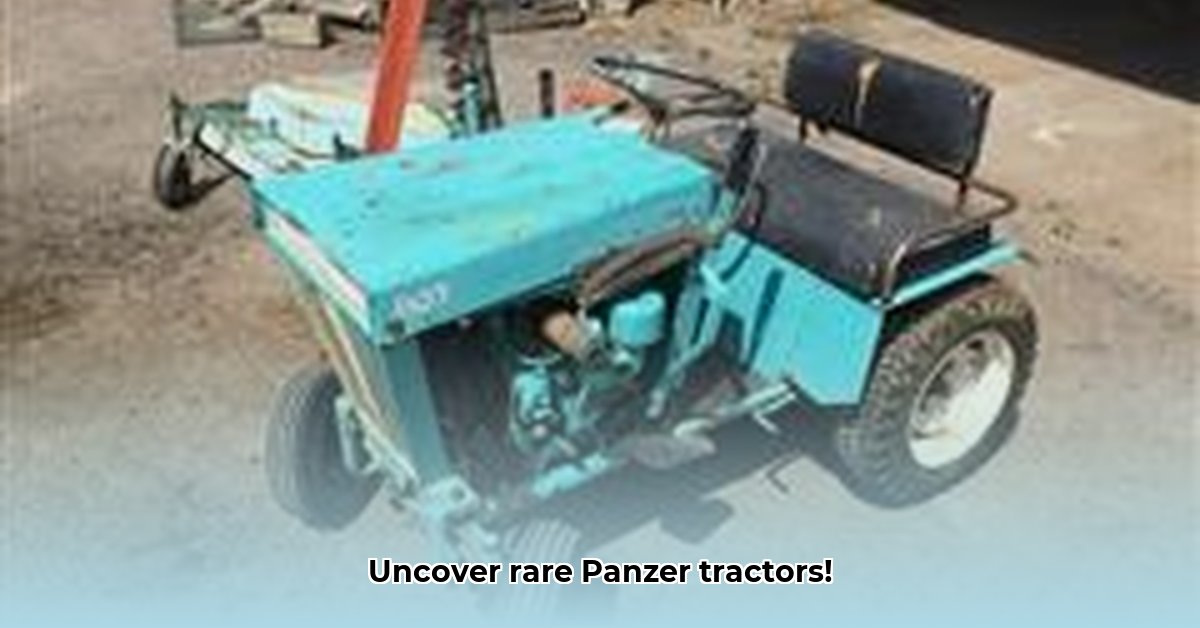
Ever dreamed of owning a piece of history that doubles as a seriously cool garden tractor? Panzer tractors aren't your average lawnmowers; they're robust, iconic machines with a captivating past. This guide unlocks the world of Panzer tractors, from finding the perfect one to keeping it running smoothly for years. We'll cover everything from sourcing these rare finds to restoration and assessing their value – whether you're a seasoned collector or a curious newcomer. For more on vintage tractors, check out this helpful resource: vintage tractor resources.
Panzer Tractor History and Significance
Panzer tractors occupy a unique niche in history. Their design reflects the engineering prowess of their era – robust construction, straightforward mechanics, and surprising versatility. Many served extensively before finding new lives on farms and in civilian projects. Their ability to endure heavy use speaks volumes about their engineering, making them ideal for rewarding restoration projects that offer a tangible link to the past. Owning one is like possessing a piece of history, a conversation starter, and a testament to enduring engineering. Isn't that appealing? These machines often saw rigorous use, which speaks to their robust design and inherent value to collectors.
Locating Your Dream Panzer Tractor
Finding the right Panzer tractor isn't a simple online search; it's a historical treasure hunt. Begin your search online; many antique tractor websites are excellent starting points. Online auction sites are also potential goldmines – keep a watchful eye! Don't underestimate the power of specialized forums and clubs dedicated to antique tractors or military vehicles; these communities often hold invaluable information and help connect you with sellers who aren't publicly advertising their tractors. Networking within these passionate groups is your secret weapon for uncovering hidden gems. How many hours should a collector realistically plan to spend on this search? It often takes months, sometimes even years, to find the perfect tractor.
Before handing over your hard-earned cash, perform a thorough inspection. Consider this due diligence.
Step-by-Step Inspection Checklist:
- Mechanical Assessment: Assess the engine, transmission, and drivetrain. Listen for any unusual noises – rattles, knocks, or anything out of the ordinary. A comprehensive mechanical check will reveal problems needing attention. A smoothly running engine is crucial, indicative of proper maintenance and overall condition.
- Authenticity Verification: Carefully examine the tractor for original markings, serial numbers, and identifying features. Cross-reference these details against known records or consult experts to verify its authenticity and origin. Authenticity significantly impacts a tractor's value.
- Restoration Needs Evaluation: Honestly assess the restoration needed. Be realistic about your skills, tools, and budget. A minor cosmetic refresh versus a full engine rebuild is a considerable difference. This is a critical step in determining the eventual return on investment.
- Price Negotiation: Research comparable sales of similar tractors to establish a fair market value. Consider the tractor's condition, necessary repairs, and your budget. Negotiate confidently and fairly. What's the typical negotiation margin on these types of tractors? Expect some give-and-take, but don't overpay.
Restoration and Maintenance: A Labor of Love
Restoring a Panzer tractor is a marathon, not a sprint. It's a rewarding process demanding patience and attention to detail.
Parts Sourcing: Finding original parts can be challenging. Reproduction parts may be an option, but their quality can vary. Active participation in collector clubs often provides access to parts networks and valuable advice. What's the most common challenge collectors face during restoration? Sourcing rare or obsolete parts is frequently the biggest hurdle.
Common Challenges: Engine overhauls, track replacements, and electrical system repairs are common. Research these potential problems beforehand. How much time should one allocate for a complete restoration? It can take anywhere from several months to several years, depending on the extent of the restoration and the collector’s skill level.
Essential Tools and Skills: You'll need a well-equipped workshop and a range of tools. Mechanical skills are essential, but don't hesitate to seek professional help for complex tasks. Is it cost-effective to hire a professional for certain aspects of restoration? Many collectors find it both more efficient and cost-effective to outsource specific tasks to specialized professionals.
Assessing Value and Collectibility
A Panzer tractor's value depends on several factors:
- Condition: Excellent condition commands a higher price. A fully restored tractor usually sells for a premium.
- Rarity: Rarer models and those with complete history are more valuable.
- Originality: Original condition tractors, especially those with documented provenance, are highly sought after.
Think of classic cars: an immaculate restoration is valuable, but an unrestored original with verified history often commands an even higher price.
Connecting with the Community
Joining online forums and clubs dedicated to Panzer tractors or military vehicles is invaluable. These communities provide knowledge, support, and camaraderie. You'll find advice, parts leads, and a shared passion that enhances your journey. Remember, buying a Panzer tractor is more than just acquiring a machine; it’s joining a fascinating community. How beneficial is participating in collector communities? Invaluable. It provides access to expert advice, parts, and a network of like-minded enthusiasts.
Remember, purchasing a Panzer tractor is a significant investment, a blend of historical significance, mechanical intrigue, and community engagement. Thoroughly research, carefully inspect, and enjoy the adventure of owning a piece of history.